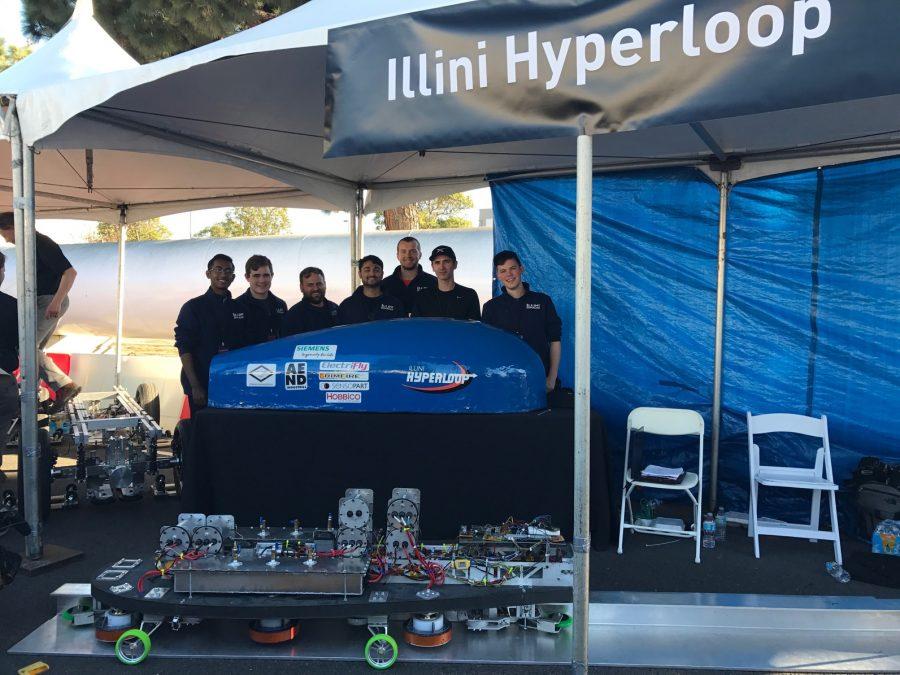UI students develop new transportation possibilities for SpaceX
Photo courtesy of Illini Hyperloop
Illini Hyperloop team demonstrates levitation on Quad Day in August.
January 30, 2017
A team of University students is working on a new mode of transportation that could potentially reduce the average three-hour trip from Champaign to Chicago to 10 or 15 minutes.
The hyperloop is a human-sized pod that sits in a depressurized tube and was created by the team for SpaceX’s Jan. 27 Hyperloop Pod Competition.
The hyperloop reduces travel time significantly, while also running solely on battery power and magnetics, cutting the need for the combustion of chemicals.
“This project is a fifth mode of transportation. It’s going to make the world feel smaller. It’ll bring people together,” said Mizan Rahman, senior in Engineering and head of the University’s Senior Design team, as well as the founder of the Hyperloop RSO.
A small group of University students began working on designs when Elon Musk, SpaceX founder, first announced the Hyperloop competition.
Get The Daily Illini in your inbox!
The University paid for a group of five students to stay on campus during the summer of 2015 and work on the group’s pod, in preparation for the Hyperloop competition.
The RSO then merged with the senior design team, a course where students designed a hyperloop and created Illini Hyperloop.
“We have very sufficient funding,” Rahman said. “We got support from the dean of Engineering (Andreas Cangellaris). He put his faith in us.”
Original design submissions were due to SpaceX in November 2015, and Illini Hyperloop was notified in December that they would be traveling to Texas A&M for Design Weekend.
After Design Weekend, the group was one of 27 given permission to continue building for the next round of competition, Competition Weekend I.
The group then had a year to complete the project but had an unveiling planned for the University’s Quad Day in August 2016.
“That was the first time that we had put all the motors on, they were all spinning up, and we levitated,” said Richard Wendel, head of electronics and sophomore in Engineering. “For me, because the software was still in the very early phase, I was scared that something was going to go horribly wrong.”
The demonstration proved to be successful, and the pod levitated on the Main Quad.
Ten months after Design Weekend, in October 2016, a few members of the group traveled to the SpaceX Headquarters in Hawthorne, California to test their design.
The pod, while close to completion, still needed some improvements. The group was able to gather data and feedback from SpaceX engineers.
Illini Hyperloop President Rishab Pohane, a sophomore in LAS, said the testing weekend helped the team anticipate what exactly SpaceX was looking for, such as certain safety features for the pod.
The team then had about three months to make changes before shipping their pod off for the January 2017 competition.
All members in Illini Hyperloop are undergraduate students, which Rahman said is unfamiliar for a competition of this scope. Most groups are comprised of paid graduate students.
“We’re basically designing all of our own infrastructures, we’re designing everything from the ground up,” Rahman said. “Aerodynamics has never done this before, no one has ever designed a system that goes in a depressurized tube that goes at the speed of sound with stuff going over it that can carry people.”
Given that this form of travel would be significantly faster than planes, Rahman said the hyperloop could redefine the world.
“For business, if you can work in San Francisco and live in Los Angeles, why not make that trip every day?” Rahman asked. “It’ll change economics for the world, this thing could be scaled up from L.A. to New York.”
Rahman, Wendel and Pohane all expect the hyperloop to become a fully functional part of society within the next 10 to 20 years since other companies around the world are also working on designs.
“It’s not just us,” Pohane said. “SpaceX is just accelerating the progress, they’re just getting the ideas floating around.”







